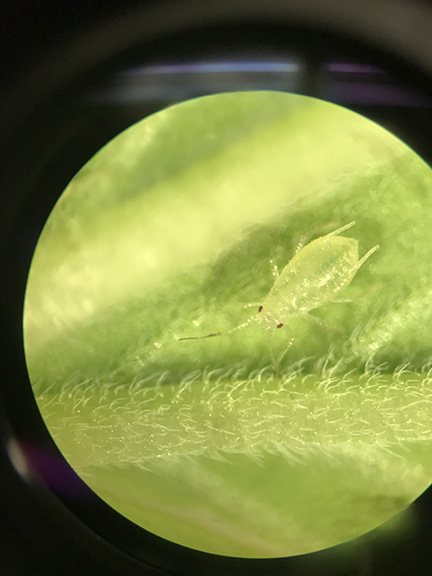As the growing season progresses, I am getting more questions about insects feeding on hemp. Contrary to literature published in the early 1900’s (Dewey. 1914), hemp does have insect and mite enemies, we just do not know which ones are economically important yet. We are in our fifth growing season of planting hemp at Meigs farm and are seeing more of the pests that have been reported in Colorado (Cranshaw and Schreiner. 2018) and are listed in “Hemp Diseases and Pests” (McPartland et al. 2000).
Many of the pests found on hemp are generalists, which may be surprising to some considering how well defended hemp plants are. Hemp produces hundreds of secondary defense compounds (ElSohly and Gul. 2014; Andre et al. 2016), yet we are seeing pests that are common in some of our other commodity crops including; flea beetles, been leaf beetles, corn earworm, and stink bugs. The pests that some growers are observing consume leaf material and the damage is minimal. We have not determined economic thresholds for hemp pests, but foliar damage is minor so far and would not warrant any kind of concern. Just because you see something eating your plant does not mean you need to panic. Pests that damage developing seeds or flowers are a concern and we will be monitoring for corn earworm, stink bugs, and Eurasian hemp borer (Grapholita delineana) this year.
In an indoor system, whether a grower is producing hemp clones or growing plants to harvestable maturity, common greenhouse pests, including spider mites and thrips, can be found feeding on hemp. We are also receiving reports of clone material coming in from Colorado with infestations of hemp russet mite (Aculops cannibicola) and cannabis aphid (Phorodon cannabis). We advise growers to inspect plant material for pests and diseases prior to accepting them. While Colorado has a list of insecticides and miticides that can be used in hemp production, no such list exists for Indiana at this point. Biological control using beneficial insects can be a tool for greenhouse pests, but we do not know which natural enemies will be most effective for hemp russet mites and cannabis aphid.
With any crop, scout for pests in your hemp and make note of damage. Take clear photos of the damage and any pests seen feeding on your hemp to help with identification. Purchasing a hand lens can be a helpful tool when looking for small pests like mites, thrips, and aphids. Good luck out there!
There has been a slight time change for the second session of the field day on July 19th, it will now end at 4:30pm.
Related References
Andre CM, Hausman J-F, Guerriero G (2016) Cannabis sativa: The Plant of the Thousand and One Molecules. Front. Plant Sci. 7:19 doi: 10.3389/fpls.2016.00019.
Cranshaw W and Schreiner M (2018) Hemp Insect Factsheets. https://hempinsects.agsci.colostate.edu/hemp-insects-text/.
Dewey L (1914) Hemp. In: USDA Yearbook 1913. pg 316.
ElSohly MA, Gul W (2014) Constituents of Cannabis sativa. In: Pertwee RG (eds) Handbook of cannabis. Oxford University Press, Oxford, UK, pp 3-22.
McPartland JM, Clarke RC, and Watson DP (2000) Hemp diseases and pests: management and biological control: an advanced treatise. CABI Pub.





